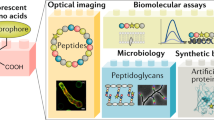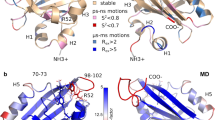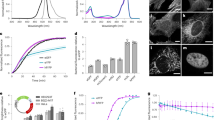Abstract
Fluorescent proteins have become indispensable imaging tools for biomedical research. Continuing progress in fluorescence imaging, however, requires probes with additional colors and properties optimized for emerging techniques. Here we summarize strategies for development of red-shifted fluorescent proteins. We discuss possibilities for knowledge-based rational design based on the photochemistry of fluorescent proteins and the position of the chromophore in protein structure. We consider advances in library design by mutagenesis, protein expression systems and instrumentation for high-throughput screening that should yield improved fluorescent proteins for advanced imaging applications.
This is a preview of subscription content, access via your institution
Access options
Subscribe to this journal
Receive 12 print issues and online access
$259.00 per year
only $21.58 per issue
Buy this article
- Purchase on Springer Link
- Instant access to full article PDF
Prices may be subject to local taxes which are calculated during checkout




Similar content being viewed by others
References
Chudakov, D.M., Matz, M.V., Lukyanov, S. & Lukyanov, K.A. Fluorescent proteins and their applications in imaging living cells and tissues. Physiol. Rev. 90, 1103–1163 (2010).
Piatkevich, K.D. & Verkhusha, V.V. Advances in engineering of fluorescent proteins and photoactivatable proteins with red emission. Curr. Opin. Chem. Biol. 14, 23–29 (2010).
Piatkevich, K.D., Malashkevich, V.N., Almo, S.C. & Verkhusha, V.V. Engineering ESPT pathways based on structural analysis of LSSmKate red fluorescent proteins with large Stokes shift. J. Am. Chem. Soc. 132, 10762–10770 (2010).
Pletnev, S., Subach, F.V., Dauter, Z., Wlodawer, A. & Verkhusha, V.V. Understanding blue-to-red conversion in monomeric fluorescent timers and hydrolytic degradation of their chromophores. J. Am. Chem. Soc. 132, 2243–2253 (2010).
Subach, O.M. et al. Structural characterization of acylimine-containing blue and red chromophores in mTagBFP and TagRFP fluorescent proteins. Chem. Biol. 17, 333–341 (2010).
Subach, O.M. et al. Conversion of red fluorescent protein into a bright blue probe. Chem. Biol. 15, 1116–1124 (2008).
Subach, F.V. et al. Monomeric fluorescent timers that change color from blue to red report on cellular trafficking. Nat. Chem. Biol. 5, 118–126 (2009).
Subach, F.V. et al. Photoactivation mechanism of PAmCherry based on crystal structures of the protein in the dark and fluorescent states. Proc. Natl. Acad. Sci. USA 106, 21097–21102 (2009).
Subach, F.V. et al. Photoactivatable mCherry for high-resolution two-color fluorescence microscopy. Nat. Methods 6, 153–159 (2009).
Subach, F.V., Patterson, G.H., Renz, M., Lippincott-Schwartz, J. & Verkhusha, V.V. Bright monomeric photoactivatable red fluorescent protein for two-color super-resolution sptPALM of live cells. J. Am. Chem. Soc. 132, 6481–6491 (2010).
Gunewardene, M.S. et al. Superresolution imaging of multiple fluorescent proteins with highly overlapping emission spectra in living cells. Biophys. J. 101, 1522–1528 (2011).
Wang, Q. et al. Molecular mechanism of a green-shifted, pH-dependent red fluorescent protein mKate variant. PLoS ONE 6, e23513 (2011).
Kremers, G.J., Hazelwood, K.L., Murphy, C.S., Davidson, M.W. & Piston, D.W. Photoconversion in orange and red fluorescent proteins. Nat. Methods 6, 355–358 (2009).
Mishin, A.S. et al. The first mutant of the Aequorea victoria green fluorescent protein that forms a red chromophore. Biochemistry 47, 4666–4673 (2008).
Bogdanov, A.M. et al. Green fluorescent proteins are light-induced electron donors. Nat. Chem. Biol. 5, 459–461 (2009).
Subach, O.M. et al. A photoswitchable orange-to-far-red fluorescent protein, PSmOrange. Nat. Methods 8, 771–777 (2010).
Chica, R.A., Moore, M.M., Allen, B.D. & Mayo, S.L. Generation of longer emission wavelength red fluorescent proteins using computationally designed libraries. Proc. Natl. Acad. Sci. USA 107, 20257–20262 (2010).
Strack, R.L. et al. A rapidly maturing far-red derivative of DsRed-Expres2 for whole-cell labeling. Biochemistry 48, 8279–8281 (2009).
Lin, M.Z. et al. Autofluorescent proteins with excitation in the optical window for intravital imaging in mammals. Chem. Biol. 16, 1169–1179 (2009).
Morozova, K.S. et al. Far-red fluorescent protein excitable with red lasers for flow cytometry and superresolution STED nanoscopy. Biophys. J. 99, L13–L15 (2010).
Hoi, H. et al. A monomeric photoconvertible fluorescent protein for imaging of dynamic protein localization. J. Mol. Biol. 401, 776–791 (2010).
Subach, F.V. et al. Red fluorescent protein with reversibly photoswitchable absorbance for photochromic FRET. Chem. Biol. 17, 745–755 (2010).
Davis, J.N. & van den Pol, A.N. Viral mutagenesis as a means for generating novel proteins. J. Virol. 84, 1625–1630 (2010).
Arakawa, H. et al. Protein evolution by hypermutation and selection in the B cell line DT40. Nucleic Acids Res. 36, e1 (2008).
Corish, P. & Tyler-Smith, C. Attenuation of green fluorescent protein half-life in mammalian cells. Protein Eng. 12, 1035–1040 (1999).
Cava, F., Hidalgo, A. & Berenguer, J. Thermus thermophilus as biological model. Extremophiles 13, 213–231 (2009).
Kwon, W.S., Da Silva, N.A. & Kellis, J.T. Jr. Relationship between thermal stability, degradation rate and expression yield of barnase variants in the periplasm of Escherichia coli. Protein Eng. 9, 1197–1202 (1996).
Martin, A., Schmid, F.X. & Sieber, V. Proside: a phage-based method for selecting thermostable proteins. Methods Mol. Biol. 230, 57–70 (2003).
Pavoor, T.V., Cho, Y.K. & Shusta, E.V. Development of GFP-based biosensors possessing the binding properties of antibodies. Proc. Natl. Acad. Sci. USA 106, 11895–11900 (2009).
Daugherty, P.S. Protein engineering with bacterial display. Curr. Opin. Struct. Biol. 17, 474–480 (2007).
Bergquist, P.L., Hardiman, E.M., Ferrari, B.C. & Winsley, T. Applications of flow cytometry in environmental microbiology and biotechnology. Extremophiles 13, 389–401 (2009).
Telford, W.G., Subach, F.V. & Verkhusha, V.V. Supercontinuum white light lasers for flow cytometry. Cytometry A 75, 450–459 (2009).
Goddard, G. et al. Single particle high resolution spectral analysis flow cytometry. Cytometry A 69, 842–851 (2006).
Houston, J.P., Naivar, M.A. & Freyer, J.P. Digital analysis and sorting of fluorescence lifetime by flow cytometry. Cytometry A 77, 861–872 (2010).
Kim, J., Kwon, D., Lee, J., Pasquier, H. & Grailhe, R. The use of Cyan Fluorescent Protein variants with a distinctive lifetime signature. Mol. Biosyst. 5, 151–153 (2009).
Goedhart, J. et al. Bright cyan fluorescent protein variants identified by fluorescence lifetime screening. Nat. Methods 7, 137–139 (2010).
Buschke, D.G. et al. Multiphoton flow cytometry to assess intrinsic and extrinsic Fluorescence in cellular aggregates: applications to stem cells. Microsc. Microanal. 17, 540–554 (2010).
Drobizhev, M., Makarov, N.S., Tillo, S.E., Hughes, T.E. & Rebane, A. Two-photon absorption properties of fluorescent proteins. Nat. Methods 8, 393–399 (2011).
Godin, J. et al. Microfluidics and photonics for Bio-System-on-a-Chip: a review of advancements in technology towards a microfluidic flow cytometry chip. J. Biophotonics 1, 355–376 (2008).
Heng, X., Hsiung, F., Sadri, A. & Patt, P. Serial line scan encoding imaging cytometer for both adherent and suspended cells. Anal. Chem. 83, 1587–1593 (2011).
Pai, J.H., Xu, W., Sims, C.E. & Allbritton, N.L. Microtable arrays for culture and isolation of cell colonies. Anal. Bioanal. Chem. 398, 2595–2604 (2010).
Kim, J. et al. Cell lysis on a microfluidic CD (compact disc). Lab Chip 4, 516–522 (2004).
Zhang, C., Xing, D. & Li, Y. Micropumps, microvalves, and micromixers within PCR microfluidic chips: advances and trends. Biotechnol. Adv. 25, 483–514 (2007).
Barbulovic-Nad, I., Au, S.H. & Wheeler, A.R. A microfluidic platform for complete mammalian cell culture. Lab Chip 10, 1536–1542 (2010).
Hofmann, M., Eggeling, C., Jakobs, S. & Hell, S.W. Breaking the diffraction barrier in fluorescence microscopy at low light intensities by using reversibly photoswitchable proteins. Proc. Natl. Acad. Sci. USA 102, 17565–17569 (2005).
Lippincott-Schwartz, J. & Patterson, G.H. Photoactivatable fluorescent proteins for diffraction-limited and super-resolution imaging. Trends Cell Biol. 19, 555–565 (2009).
Wu, B., Piatkevich, K.D., Lionnet, T., Singer, R.H. & Verkhusha, V.V. Modern fluorescent proteins and imaging technologies to study gene expression, nuclear localization, and dynamics. Curr. Opin. Cell Biol. 23, 310–317 (2011).
Davidson, M.W. & Campbell, R.E. Engineered fluorescent proteins: innovations and applications. Nat. Methods 6, 713–717 (2009).
Nienhaus, G.U. & Wiedenmann, J. Structure, dynamics and optical properties of fluorescent proteins: perspectives for marker development. ChemPhysChem 10, 1369–1379 (2009).
Post, J.N., Lidke, K.A., Rieger, B. & Arndt-Jovin, D.J. One- and two-photon photoactivation of a paGFP-fusion protein in live Drosophila embryos. FEBS Lett. 579, 325–330 (2005).
Acknowledgements
This work was supported by US National Institutes of Health grants GM073913 and CA164468 to V.V.V.
Author information
Authors and Affiliations
Corresponding author
Ethics declarations
Competing interests
The authors declare no competing financial interests.
Supplementary information
Supplementary Text and Figures
Supplementary Figure 1, Supplementary Tables 1–4 and Supplementary Note (PDF 329 kb)
Rights and permissions
About this article
Cite this article
Subach, F., Piatkevich, K. & Verkhusha, V. Directed molecular evolution to design advanced red fluorescent proteins. Nat Methods 8, 1019–1026 (2011). https://doi.org/10.1038/nmeth.1776
Published:
Issue Date:
DOI: https://doi.org/10.1038/nmeth.1776
This article is cited by
-
Dual-expression system for blue fluorescent protein optimization
Scientific Reports (2022)
-
Advanced imaging and labelling methods to decipher brain cell organization and function
Nature Reviews Neuroscience (2021)
-
Expression and Characterization of a Bright Far-red Fluorescent Protein from the Pink-Pigmented Tissues of Porites lobata
Marine Biotechnology (2020)
-
NTnC-like genetically encoded calcium indicator with a positive and enhanced response and fast kinetics
Scientific Reports (2018)
-
Significant expansion and red-shifting of fluorescent protein chromophore determined through computational design and genetic code expansion
Biophysics Reports (2018)



